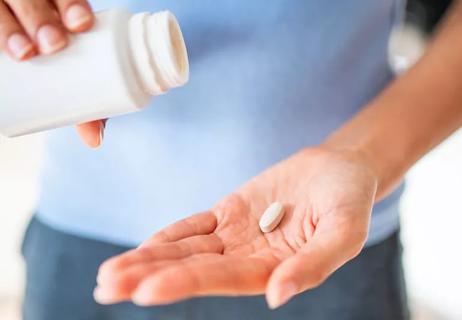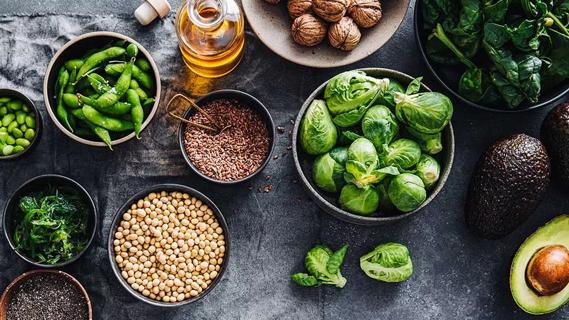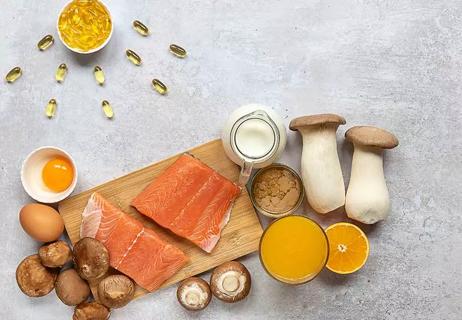Vitamins A, D, E and K stay in your body longer and are best eaten with a bit of healthy fat

When it comes to vitamins, there are two big camps: The fat-soluble types and the water-soluble varieties.
Advertisement
Cleveland Clinic is a non-profit academic medical center. Advertising on our site helps support our mission. We do not endorse non-Cleveland Clinic products or services. Policy
To keep your body functioning at its best, you need adequate amounts of both.
And when it comes to fat-soluble vitamins, there are some tips and tricks you should consider to ensure you’re getting the most from your daily intake.
The fat-soluble vitamins are A, D, E and K. They tend to come from animal and dairy products but can also be found in some fruits and vegetables. And they’re important for several functions in your body, including your vision, bone health, immunity and blood clotting.
We talked with family physician Matthew Goldman, MD, about each of these fat-soluble vitamins and how to get the most out of these important nutrients.
There are four fat-soluble vitamins:
Dr. Goldman breaks each down, including what they do, how much you need and where to find them.
Vitamin A is most closely associated with your vision. It also plays a big role in keeping your skin and hair healthy and boosting your immunity.
How much you should get
The U.S. Food and Drug Administration (FDA) recommends a daily value of 900 micrograms (mcg) of vitamin A for adults and children aged 4 and older.
Vitamin A foods
Your body doesn’t naturally create vitamin A. It only comes from the foods you eat. Vitamin A is found in animal products, as well as some fruits and vegetables, particularly orange ones.
Advertisement
| Food | Serving size | Micrograms per serving |
|---|---|---|
| Sweet potatoes | 1 potato | 1,403 |
| Spinach | 1/2 cup | 573 |
| Raw carrots | 1/2 cup | 459 |
| Pickled Atlantic herring | 3 ounces | 219 |
| Cantaloupe | 1/2 cup | 135 |
| Sweet red peppers | 1/2 cup | 117 |
| Mango | 1 mango | 112 |
| Hard-boiled eggs | 1 large egg | 75 |
| Black-eyed peas | 1 cup | 66 |
| Dried apricots | 5 apricots | 63 |
| Food | ||
| Sweet potatoes | ||
| Serving size | ||
| 1 potato | ||
| Micrograms per serving | ||
| 1,403 | ||
| Spinach | ||
| Serving size | ||
| 1/2 cup | ||
| Micrograms per serving | ||
| 573 | ||
| Raw carrots | ||
| Serving size | ||
| 1/2 cup | ||
| Micrograms per serving | ||
| 459 | ||
| Pickled Atlantic herring | ||
| Serving size | ||
| 3 ounces | ||
| Micrograms per serving | ||
| 219 | ||
| Cantaloupe | ||
| Serving size | ||
| 1/2 cup | ||
| Micrograms per serving | ||
| 135 | ||
| Sweet red peppers | ||
| Serving size | ||
| 1/2 cup | ||
| Micrograms per serving | ||
| 117 | ||
| Mango | ||
| Serving size | ||
| 1 mango | ||
| Micrograms per serving | ||
| 112 | ||
| Hard-boiled eggs | ||
| Serving size | ||
| 1 large egg | ||
| Micrograms per serving | ||
| 75 | ||
| Black-eyed peas | ||
| Serving size | ||
| 1 cup | ||
| Micrograms per serving | ||
| 66 | ||
| Dried apricots | ||
| Serving size | ||
| 5 apricots | ||
| Micrograms per serving | ||
| 63 |
Known as the “sunshine vitamin,” your body creates vitamin D from exposure to sunlight. It’s found naturally in very few foods.
Vitamin D is important for bone and muscle health and can help protect you from osteoporosis. It also supports your immune system and promotes brain health.
How much you should get
The FDA recommends a daily value of 15 mcg of vitamin D for adults and children age 1 and older.
Babies under 1-year-old need about 10 micrograms of vitamin D per day. Vitamin D doesn’t get passed in breast milk, so babies who are breastfed/chestfed should get a daily vitamin D supplement. Formula-fed babies also need vitamin D supplements for their first several months of life, until they drink at least 32 ounces of vitamin D-fortified formula per day. Your child’s pediatrician can best advise you on your baby’s nutritional needs.
Vitamin D foods
You get most of your vitamin D through exposure to sunlight, rather than food. It’s not found in many foods naturally. But some packaged foods may be fortified with vitamin D.
| Food | Serving size | Micrograms per serving |
|---|---|---|
| Cod liver oil | 1 tablespoon | 34 |
| Cooked rainbow trout | 3 ounces | 16.2 |
| Cooked sockeye salmon | 3 ounces | 14.2 |
| White mushrooms | 1/2 cup | 9.2 |
| 2% milk (vitamin D-fortified) | 1 cup | 2.9 |
| Vitamin D-fortified soy and oat milks | 1 cup | 2.5 to 3.6 |
| Vitamin D-fortified cereal | 1 serving (as listed on nutrition label) | 2 |
| Food | ||
| Cod liver oil | ||
| Serving size | ||
| 1 tablespoon | ||
| Micrograms per serving | ||
| 34 | ||
| Cooked rainbow trout | ||
| Serving size | ||
| 3 ounces | ||
| Micrograms per serving | ||
| 16.2 | ||
| Cooked sockeye salmon | ||
| Serving size | ||
| 3 ounces | ||
| Micrograms per serving | ||
| 14.2 | ||
| White mushrooms | ||
| Serving size | ||
| 1/2 cup | ||
| Micrograms per serving | ||
| 9.2 | ||
| 2% milk (vitamin D-fortified) | ||
| Serving size | ||
| 1 cup | ||
| Micrograms per serving | ||
| 2.9 | ||
| Vitamin D-fortified soy and oat milks | ||
| Serving size | ||
| 1 cup | ||
| Micrograms per serving | ||
| 2.5 to 3.6 | ||
| Vitamin D-fortified cereal | ||
| Serving size | ||
| 1 serving (as listed on nutrition label) | ||
| Micrograms per serving | ||
| 2 |
Vitamin D deficiencies are common. And vitamin D supplements can be beneficial for a lot of people, particularly people who have limited exposure to sunlight and people with darker skin. We’ll talk more about vitamin D deficiencies in a bit.
Vitamin E is a powerful antioxidant. That means it helps fight off the free radicals that lead to aging and chronic disease. You’ll often see vitamin E as an ingredient in skin care products, particularly products marketed as “anti-aging” or “softening.”
As part of your diet, research on vitamin E is ongoing. But there’s evidence to show that vitamin E may provide some protection from heart disease, cancer, eye disorders and cognitive decline.
How much you should get
The FDA recommends a daily value of 15 milligrams (mg) of vitamin E for adults and children 4 and older.
Vitamin E foods
Many nuts and oils are natural sources of vitamin E. Some packaged foods may also be fortified with vitamin E.
| Food | Serving size | Milligrams per serving |
|---|---|---|
| Wheat germ oil | 1 tablespoon | 20.3 |
| Sunflower seeds | 1 ounce | 7.4 |
| Almonds | 1 ounce | 6.8 |
| Sunflower oil | 1 tablespoon | 5.6 |
| Safflower oil | 1 tablespoon | 4.6 |
| Hazelnuts | 1 ounce | 4.3 |
| Peanut butter | 2 tablespoons | 2.9 |
| Peanuts | 1 ounce | 2.2 |
| Corn oil | 1 tablespoon | 1.9 |
| Spinach | 1/2 cup | 1.2 |
| Food | ||
| Wheat germ oil | ||
| Serving size | ||
| 1 tablespoon | ||
| Milligrams per serving | ||
| 20.3 | ||
| Sunflower seeds | ||
| Serving size | ||
| 1 ounce | ||
| Milligrams per serving | ||
| 7.4 | ||
| Almonds | ||
| Serving size | ||
| 1 ounce | ||
| Milligrams per serving | ||
| 6.8 | ||
| Sunflower oil | ||
| Serving size | ||
| 1 tablespoon | ||
| Milligrams per serving | ||
| 5.6 | ||
| Safflower oil | ||
| Serving size | ||
| 1 tablespoon | ||
| Milligrams per serving | ||
| 4.6 | ||
| Hazelnuts | ||
| Serving size | ||
| 1 ounce | ||
| Milligrams per serving | ||
| 4.3 | ||
| Peanut butter | ||
| Serving size | ||
| 2 tablespoons | ||
| Milligrams per serving | ||
| 2.9 | ||
| Peanuts | ||
| Serving size | ||
| 1 ounce | ||
| Milligrams per serving | ||
| 2.2 | ||
| Corn oil | ||
| Serving size | ||
| 1 tablespoon | ||
| Milligrams per serving | ||
| 1.9 | ||
| Spinach | ||
| Serving size | ||
| 1/2 cup | ||
| Milligrams per serving | ||
| 1.2 |
Vitamin K helps build strong bones, regulates blood clotting and keeps your blood pressure in check.
How much you should get
The FDA recommends a daily value of 120 mcg of vitamin K for adults and children age 4 and older.
People who are taking a blood thinning medication, such as warfarin (Coumadin®), should talk with a healthcare provider about their recommended vitamin K intake. That’s because large quantities of vitamin K can raise the risk of blood clots for people on those medications.
Advertisement
Vitamin K foods
There are two types of vitamin K: vitamin K1 and vitamin K2. They do similar things for your body, but come from different food sources.
Vitamin K1 is typically associated with leafy greens and other veggies. Vitamin K2 is mostly found in dairy and animal products.
These foods are high in vitamin K:
| Food | Serving size | Micrograms per serving |
|---|---|---|
| Nattō (fermented soy) | 3 ounces | 850 |
| Collard greens | 1/2 cup | 530 |
| Boiled turnip greens | 1/2 cup | 426 |
| Raw spinach | 1/2 cup | 72.5 |
| Raw kale | 1/2 cup | 57 |
| Cooked broccoli | 1/2 cup | 110 |
| Dry roasted cashews | 1/2 cup | 80 |
| Roasted soybeans | 1/2 cup | 43 |
| Soybean oil | 1 tablespoon | 25 |
| Prepared frozen edamame | 1/2 cup | 21 |
| Food | ||
| Nattō (fermented soy) | ||
| Serving size | ||
| 3 ounces | ||
| Micrograms per serving | ||
| 850 | ||
| Collard greens | ||
| Serving size | ||
| 1/2 cup | ||
| Micrograms per serving | ||
| 530 | ||
| Boiled turnip greens | ||
| Serving size | ||
| 1/2 cup | ||
| Micrograms per serving | ||
| 426 | ||
| Raw spinach | ||
| Serving size | ||
| 1/2 cup | ||
| Micrograms per serving | ||
| 72.5 | ||
| Raw kale | ||
| Serving size | ||
| 1/2 cup | ||
| Micrograms per serving | ||
| 57 | ||
| Cooked broccoli | ||
| Serving size | ||
| 1/2 cup | ||
| Micrograms per serving | ||
| 110 | ||
| Dry roasted cashews | ||
| Serving size | ||
| 1/2 cup | ||
| Micrograms per serving | ||
| 80 | ||
| Roasted soybeans | ||
| Serving size | ||
| 1/2 cup | ||
| Micrograms per serving | ||
| 43 | ||
| Soybean oil | ||
| Serving size | ||
| 1 tablespoon | ||
| Micrograms per serving | ||
| 25 | ||
| Prepared frozen edamame | ||
| Serving size | ||
| 1/2 cup | ||
| Micrograms per serving | ||
| 21 |
As fat-soluble vitamins, vitamins A, D, E and K dissolve in fat and oils.
That means the fat-soluble vitamins in the foods you eat get absorbed by the fats you eat. It’s fat that allows them to get into your bloodstream, circulate all over your body and keep you in tip-top shape.
“Fat-soluble vitamins are best absorbed when eaten with healthy fats,” Dr. Goldman explains.
That means that along with your vitamin-rich foods, you’ll get the most nutritional bang for your buck if you layer on a bit of healthy fat, too. That can be foods like avocados, olive oil, seeds, nuts and vegetable oil.
But you probably don’t need to think about it too hard if you’re already eating a relatively well-balanced diet.
“If you’re eating a variety of whole foods, you’ll most likely get enough healthy fats in your diet to absorb these vitamins,” Dr. Goldman notes.
If you’re relying on supplements to get your fill of fat-soluble vitamins, take them along with a healthy snack or meal.
Advertisement
Unlike water-soluble vitamins, which are quickly passed through your body and excreted in your urine, your body stores up fat-soluble vitamins like a rainy-day fund.
“Fat-soluble vitamins are stored in your body’s fatty tissue and in your liver for a long time,” Dr. Goldman explains.
Because your body holds on to fat-soluble vitamins, most people who have adequate access to nutritious foods get plenty of vitamins A, E and K in their diets without trying too hard.
Vitamin D deficiencies, on the other hand, are pretty common. That’s because vitamin D isn’t readily found in a lot of foods, and many people don’t get enough sunlight for their bodies to make sufficient amounts of vitamin D. Vitamin D deficiency has even been called “an ignored epidemic.” More than a billion people across the globe have vitamin D deficiency.
But there’s another side to it. Because fat-soluble vitamins stick around in your body, it’s possible to get too much of a good thing.
“It’s possible for fat-soluble vitamins to become toxic in excess. So, it’s important not to exceed the recommended daily dose,” Dr. Goldman warns. “Generally, it’s best to get fat-soluble vitamins from food sources rather than supplements, unless a healthcare provider has specifically recommended supplements for you.”
Advertisement
In other words, you’re probably not going to get excessive or dangerous amounts of vitamins A, D, E and K from your diet. But if you’re taking supplements, too, you’ll want to be careful about going overboard.
If you have questions about whether you’re getting the right amount of fat-soluble vitamins in your diet, be sure to talk with a healthcare provider.
Learn more about our editorial process.
Advertisement

Vitamin A toxicity can cause drug interactions, fetal development issues and other side effects

There are several vitamins and mineral supplements that many people can benefit from — but it’s important to consult with a healthcare provider before you start one

A daily dose of vitamin D can help babies build strong bones, as well as boost their brain development

Easy to get from healthy foods, vitamin E can help protect your eyes, boost your immune system and may lower your risk of cancer

Research shows that high doses of vitamin D do nothing to lower your cardiovascular risk

If you’ve been diagnosed with breast cancer, having a normal range of vitamin D can help

It’s always best to talk to a healthcare provider before taking any supplements to avoid toxicity

Type 2 diabetes isn’t inevitable with these dietary changes

Applying a hot or cold compress can help with pain